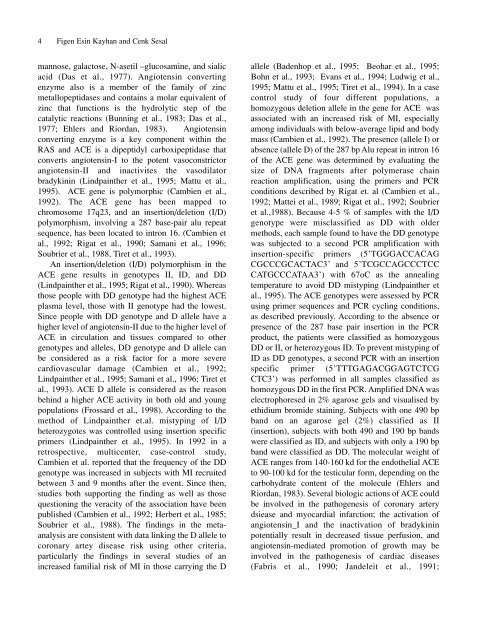Full Journal - Journal of Cell and Molecular Biology - Haliç Üniversitesi
Full Journal - Journal of Cell and Molecular Biology - Haliç Üniversitesi
Full Journal - Journal of Cell and Molecular Biology - Haliç Üniversitesi
You also want an ePaper? Increase the reach of your titles
YUMPU automatically turns print PDFs into web optimized ePapers that Google loves.
4 Figen Esin Kayhan <strong>and</strong> Cenk Sesal<br />
mannose, galactose, N-asetil –glucosamine, <strong>and</strong> sialic<br />
acid (Das et al., 1977). Angiotensin converting<br />
enzyme also is a member <strong>of</strong> the family <strong>of</strong> zinc<br />
metallopeptidases <strong>and</strong> contains a molar equivalent <strong>of</strong><br />
zinc that functions is the hydrolytic step <strong>of</strong> the<br />
catalytic reactions (Bunning et al., 1983; Das et al.,<br />
1977; Ehlers <strong>and</strong> Riordan, 1983). Angiotensin<br />
converting enzyme is a key component within the<br />
RAS <strong>and</strong> ACE is a dipeptidyl carboxipeptidase that<br />
converts angiotensin-I to the potent vasoconstrictor<br />
angiotensin-II <strong>and</strong> inactivites the vasodilator<br />
bradykinin (Lindpainther et al., 1995; Mattu et al.,<br />
1995). ACE gene is polymorphic (Cambien et al.,<br />
1992). The ACE gene has been mapped to<br />
chromosome 17q23, <strong>and</strong> an insertion/deletion (I/D)<br />
polymorphism, involving a 287 base-pair alu repeat<br />
sequence, has been located to intron 16. (Cambien et<br />
al., 1992; Rigat et al., 1990; Samani et al., 1996;<br />
Soubrier et al., 1988, Tiret et al., 1993).<br />
An insertion/deletion (I/D) polymorphism in the<br />
ACE gene results in genotypes II, ID, <strong>and</strong> DD<br />
(Lindpainther et al., 1995; Rigat et al., 1990). Whereas<br />
those people with DD genotype had the highest ACE<br />
plasma level, those with II genotype had the lowest.<br />
Since people with DD genotype <strong>and</strong> D allele have a<br />
higher level <strong>of</strong> angiotensin-II due to the higher level <strong>of</strong><br />
ACE in circulation <strong>and</strong> tissues compared to other<br />
genotypes <strong>and</strong> alleles, DD genotype <strong>and</strong> D allele can<br />
be considered as a risk factor for a more severe<br />
cardiovascular damage (Cambien et al., 1992;<br />
Lindpainther et al., 1995; Samani et al., 1996; Tiret et<br />
al., 1993). ACE D allele is considered as the reason<br />
behind a higher ACE activity in both old <strong>and</strong> young<br />
populations (Frossard et al., 1998). According to the<br />
method <strong>of</strong> Lindpainther et.al. mistyping <strong>of</strong> I/D<br />
heterozygotes was controlled using insertion specific<br />
primers (Lindpainther et al., 1995). In 1992 in a<br />
retrospective, multicenter, case-control study,<br />
Cambien et al. reported that the frequency <strong>of</strong> the DD<br />
genotype was increased in subjects with MI recruited<br />
between 3 <strong>and</strong> 9 months after the event. Since then,<br />
studies both supporting the finding as well as those<br />
questioning the veracity <strong>of</strong> the association have been<br />
published (Cambien et al., 1992; Herbert et al., 1985;<br />
Soubrier et al., 1988). The findings in the metaanalysis<br />
are consistent with data linking the D allele to<br />
coronary artey disease risk using other criteria,<br />
particularly the findings in several studies <strong>of</strong> an<br />
increased familial risk <strong>of</strong> MI in those carrying the D<br />
allele (Badenhop et al., 1995; Beohar et al., 1995;<br />
Bohn et al., 1993; Evans et al., 1994; Ludwig et al.,<br />
1995; Mattu et al., 1995; Tiret et al., 1994). In a case<br />
control study <strong>of</strong> four different populations, a<br />
homozygous deletion allele in the gene for ACE was<br />
associated with an increased risk <strong>of</strong> MI, especially<br />
among individuals with below-average lipid <strong>and</strong> body<br />
mass (Cambien et al., 1992). The presence (allele I) or<br />
absence (allele D) <strong>of</strong> the 287 bp Alu repeat in intron 16<br />
<strong>of</strong> the ACE gene was determined by evaluating the<br />
size <strong>of</strong> DNA fragments after polymerase chain<br />
reaction amplification, using the primers <strong>and</strong> PCR<br />
conditions described by Rigat et. al (Cambien et al.,<br />
1992; Mattei et al., 1989; Rigat et al., 1992; Soubrier<br />
et al.,1988). Because 4-5 % <strong>of</strong> samples with the I/D<br />
genotype were misclassified as DD with older<br />
methods, each sample found to have the DD genotype<br />
was subjected to a second PCR amplification with<br />
insertion-specific primers (5’TGGGACCACAG<br />
CGCCCGCACTAC3’ <strong>and</strong> 5’TCGCCAGCCCTCC<br />
CATGCCCATAA3’) with 67oC as the annealing<br />
temperature to avoid DD mistyping (Lindpainther et<br />
al., 1995). The ACE genotypes were assessed by PCR<br />
using primer sequences <strong>and</strong> PCR cycling conditions,<br />
as described previously. According to the absence or<br />
presence <strong>of</strong> the 287 base pair insertion in the PCR<br />
product, the patients were classified as homozygous<br />
DD or II, or heterozygous ID. To prevent mistyping <strong>of</strong><br />
ID as DD genotypes, a second PCR with an insertion<br />
specific primer (5’TTTGAGACGGAGTCTCG<br />
CTC3’) was performed in all samples classified as<br />
homozygous DD in the first PCR. Amplified DNA was<br />
electrophoresed in 2% agarose gels <strong>and</strong> visualised by<br />
ethidium bromide staining. Subjects with one 490 bp<br />
b<strong>and</strong> on an agarose gel (2%) classified as II<br />
(insertion), subjects with both 490 <strong>and</strong> 190 bp b<strong>and</strong>s<br />
were classified as ID, <strong>and</strong> subjects with only a 190 bp<br />
b<strong>and</strong> were classified as DD. The molecular weight <strong>of</strong><br />
ACE ranges from 140-160 kd for the endothelial ACE<br />
to 90-100 kd for the testicular form, depending on the<br />
carbohydrate content <strong>of</strong> the molecule (Ehlers <strong>and</strong><br />
Riordan, 1983). Several biologic actions <strong>of</strong> ACE could<br />
be involved in the pathogenesis <strong>of</strong> coronary artery<br />
dsiease <strong>and</strong> myocardial infarction; the activation <strong>of</strong><br />
angiotensin_I <strong>and</strong> the inactivation <strong>of</strong> bradykinin<br />
potentially result in decreased tissue perfusion, <strong>and</strong><br />
angiotensin-mediated promotion <strong>of</strong> growth may be<br />
involved in the pathogenesis <strong>of</strong> cardiac diseases<br />
(Fabris et al., 1990; J<strong>and</strong>eleit et al., 1991;

















